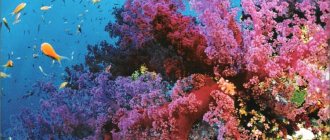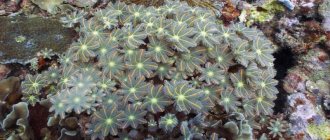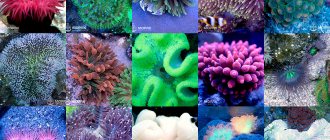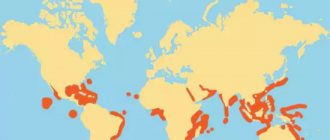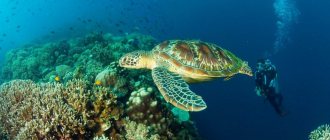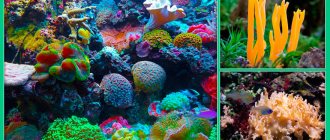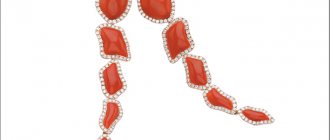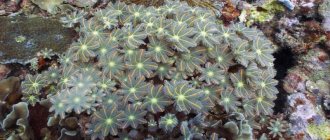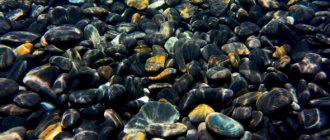Playing a large role in the marine ecosystem, these organisms were classified as plants for many years. In this article we will try to figure out whether corals are animals or plants. Unfortunately, no matter what class these organisms belong to, they are now in danger of extinction.
- Interesting facts about fish
- Barracuda: aggressive and unpredictable
- Sea lion: habitat
Corals decorate the shores and bottom of the oceans. Many scuba divers and divers simply love to enjoy their beauty. But the question regarding their class remains relevant to this day.
Are corals animals...or are they?
Corals are animals
Back in the 9th century, the Muslim scientist Al-Biruni classified sea sponges and corals as animals, claiming that they responded to touch. However, for many years these organisms were cataloged as plants, until in the 18th century, upon closer examination, animal cells were discovered in their composition, which means it makes no sense to classify them as vegetation. For many years, these organisms were considered sea flowers, but no, corals are animals.
Coral is a mass of many individual multicellular organisms deposited on a limestone base, called polyps. They are usually several millimeters in diameter and consist of an outer layer of epithelium and a gelatinous inner tissue known as mesoglea.
There are more than 70,000 different species of corals in the world. The bulk lives in a warm, tropical climate. Yes, they don't like the cold. It is for this reason that the largest colonies are found in the warm waters of the Caribbean or Pacific Ocean.
Well, we have already solved the most important dilemma; corals are animals. But what do we know about these organisms? Next, let's look at some of the most important and interesting facts about them.
Other interesting facts
- In total, there are about 6,000 types of coral polyps, and only 25 of them are used in jewelry;
- from 1 to 3 cm - this is how much coral grows in a year!
- stinging coral is not actually one - it is a separate species that poses a danger to humans due to the toxicity of its tentacles;
- amazingly beautiful reefs and atolls are under threat of extinction due to human activity;
- off the coast of Australia is the longest atoll in the world, its length is 2500 km!
- if you look inside the coral, you can see peculiar rings there - annual, like those of trees;
- many fish and marine animals prefer reefs when spawning, this allows the eggs to be kept safe from various predators;
- reefs are a kind of plant filter, since they trap floating organisms around them that pollute the water.
Feeding
Most corals obtain their energy and nutrients from single-celled photosynthetic organisms that live in symbiosis with polyps in their tissue. Although some corals are capable of catching and feeding on plankton and sometimes small fish. Such organisms are carnivorous; in addition to fish, their diet also includes small marine animals. The polyp's tentacles immobilize or kill prey using their nematocysts. These cells carry a poison that is quickly released in response to contact with another organism.
What do corals eat?
They live together with algae - single-celled zooxanthellae. When the algae die, the polyp turns white, and after a while it also dies. This effect is scientifically called “coral bleaching.”
The fact that the polyp prefers just such a “cohabitation” is not at all surprising, because algae provide them with food. But in fact, polyps can feed in different ways: by consuming plankton or through photosynthesis, which is carried out by these algae.
It is this fact that explains why animals do not live on the seabed, because, as you know, there is no sunlight at all. Namely, its presence ensures photosynthesis, thanks to which polyps receive nutrients.
Threat of extinction
The threat of extinction of corals is a fact that needs to be known. Corals are animals and they play a significant role in the ecosystem. Recent studies have shown that by 2030, at least 50% of the world's coral formations will cease to exist. This is influenced by many factors: coral mining, agricultural and urban runoff, pollution (organic and inorganic), overfishing, including poaching, canal digging, natural disasters. More serious threats to coral ecosystems are rising sea temperatures, rising sea levels, and changes in pH from ocean acidification, all of which are linked to greenhouse gas emissions. In 1998, 16% of the world's reefs died as a result of rising water temperatures.
Death of corals
Surprisingly, corals die due to microbes. According to the experiments carried out, it was revealed that the polyps had a trigger mechanism, which begins the process of their “death”. They die from the high content of organic matter in the water, as well as from sediment. It is clear that this phenomenon is the “work” of microbes.
How does this happen? When a large amount of organic matter begins to accumulate in water, it “attracts” various pathogenic organisms. Naturally, their growth increases and their number increases. This leads to a lack of oxygen and a change in the pH of the environment. This phenomenon is simply destructive for polyps.
From birth to death
At first they look like a tiny sac covered with cilia. After swimming, they settle to the bottom, become attached, and lose their cilia. At the upper end of the sac, a mouth breaks through and short tentacles grow. The result is a polyp - something like a freshwater hydra from a school zoology textbook. The polyp catches small water particles with its tentacles. From time to time, bumps appear on its sides. They grow, become hollow, and tentacles and a mouth appear at the end. These descendants do not separate from the founder polyp, but feed, grow, and new branches-polyps appear on them. This is how a coral colony gradually forms.
For a normal life, a colony must catch a fairly large volume of water. Therefore, it is necessary that the branches not only spread along the bottom, but also stretch upward. This provides a strong skeleton: calcareous grains of calcium carbonate are deposited inside their gelatinous body. Over the years, the polyps on the lower “floors” die off. However, their skeletons remain, are compressed, and new polyps of the colony grow on this foundation.
Coral sizes and something else
Polyps are quite tiny, their size usually does not exceed a few centimeters. As for the colony that these creatures form, that is a completely different matter. For example, polyps of madrepore coral can reach 40-50 cm in diameter. Individual individuals are connected to each other through a coenosarc. As a result, a single organism is formed. All individuals obtain food together. The larger ones catch particles, the smaller ones participate in reproduction. So we have already figured out what corals are. Is it an animal or a plant? You already know the answer to this question. It is worth paying attention to the fact that the oldest coral reefs were created 23 million years ago. This suggests that the polyps appeared a very long time ago. As noted a little above, for the most part reefs present a large number of dead individuals. The exception is the top layer, which has formed recently.
Where are the most beautiful coral reefs?
Australia's Great Barrier Reef is the largest reef system in the world and can be seen from space. Covering an area of 133,000 square miles, it consists of more than 2,900 individual reefs and 1,050 islands, stretching over 1,400 miles.
The Belize Reef Barrier is the second largest in the world after Australia's Great Coral Barrier. The reef barrier is about 300 kilometers long and 40 kilometers wide. The atolls are located beyond the barrier and offer extraordinary dives.
The clear waters surrounding the Andros Archipelago in the Bahamas are ideal for diving. The corals extend over 225 km along the eastern coast of Andros to the end of the “Tongue of the Ocean”. An ocean trench whose depth falls from 35 to 1800 meters.
How are corals formed and where do they live?
The body of the polyp is very delicate, so for its protection it builds a small limestone cell called a calyx. Cup sticks to cup, and the result is coral reefs that resemble a fairy tale kingdom.
If you swim up to the reef, you will see a completely extraordinary underwater forest. There are colonies of reefs, similar in shape to Christmas trees, dense thorny bushes, mushrooms, giant funnels, vases, bowls, trees. Bright colors predominate: lemon yellow, emerald green, light brown, crimson.
In the dense thickets of corals, numerous shellfish, fish and many other animals find shelter and food. Some of them hide inside the colony all their lives. Sometimes the reef is overgrown by such an animal on all sides, and it ends up forever walled up in the thickness of the corals, receiving food through small holes. Other aquatic inhabitants take refuge in the thickets only when there is danger, while others constantly crawl along the surface of the colony or stay close.
For a coral reef to grow and thrive, it needs favorable conditions. Sea water should have normal ocean salinity . Therefore, during heavy rains, when the salinity in the coastal parts of the sea decreases, a large number of corals die. This has bad consequences for various sea creatures, as the decaying coral tissue poisons the water and causes death to marine animals.
The second condition for coral life is high and constant water temperature . Due to this, most reefs are found in the tropical parts of the Pacific, Indian and Atlantic oceans. The next important condition for the normal functioning of corals is the purity and transparency of sea water . Transparent water allows the sun's rays to pass through better. And most importantly, corals need food; they feed on microscopic animals from plankton.
A large expanse of tropical oceans is suitable for corals to thrive. The area of their structures amounts to more than 27 million square meters. km. The area of the islands and reefs alone, which are exposed at low tide, is 8 million square meters. km., this is larger than the area of Australia (7.7 million sq. km). The largest coral reef is located off the coast of Australia - the Great Barrier Reef, which stretches for many thousands of kilometers.
There are coastal reefs that are located along the shores of islands or continents. Barrier reefs are located at some distance from the coast and atolls are coral islands.
The coral islands are very similar to each other. Coconut palms and a white strip of coastal beach can be seen from afar. The vegetation of the coral islands is monotonous; here there are plants with wide and long leaves, called pandanus. Their bushes grow fruits that are very similar in shape to a pineapple. You can also see cacti and tall, coarse grass here.
The entire space occupied by the coral reef is a huge natural lime factory. Year after year, small polyps extract lime from sea water and deposit it in their bodies. Since corals settle near the surface of the sea (along the shores of islands, or form an island themselves), lime is easily accessible, and its reserves are almost unlimited.
Corals are widely used in agriculture. In coastal tropical countries they are used as a building material for houses and paving streets. Corals are used for polishing and grinding wooden and metal products, for making medicines, and also as decoration for artificial rocks in gardens, parks and aquariums.
In the tropics there are many islands that emerged from coral reefs. Since there is no natural stone on them, corals are used as heavy objects to crush fruits or grind seeds.
Since ancient times, corals have been attributed magical properties. Amulets made from them protected their owner from witchcraft and disease. Corals are also sold as souvenirs, which are eagerly purchased not only by visitors, but also by local residents.
Tags: tropics, islands, animals, water, ocean, sea, coral polyps
Properties
Because of its softness and opacity, coral is usually cut into cabochons or used to make beads.
Physicochemical characteristics
Consist mainly of calcium carbonate (CaCO3); admixtures of other substances (for example, magnesium carbonate, iron oxide or even organic matter) determine the color of the jewelry.
Black coral (“akkabar”) consists almost entirely of organic matter.
We are treated with corals
- According to lithotherapists, coral is the owner of the Yin principle. It improves memory, stimulates metabolism, improves blood circulation and the cardiovascular system responsible for it.
- The gift of the tropics has the ability to recognize poisons. Ivan the Terrible (as recorded by the English merchant J. Horsey) said: “Here is a beautiful coral and a beautiful turquoise, ... their natural color is bright; now put them on my hand. I am poisoned by disease, you see, they show their property by changing color from clear to dull, they predict my death.”
- In folk medicine of Central Asia, coral is an almost universal remedy. Its powder is used to cleanse the eyes, strengthen the heart, against lung diseases and intestinal ulcers... It promised numerous offspring to a woman who wore coral jewelry.
- “Ayurveda” believes that the stone has contraceptive properties (apparently, it “adapts” to the desires of the wearer...) It is useful to wear coral for asthma or thyroid diseases.
- Modern medicine has also appreciated the mineral: prostheses are made from it to replace dead areas of bone (by the way, the Japanese also use white coral powder to heal bones).
- Modern suppliers of black coral claim that it not only destroys harmful chemicals in the body, but also helps against colds, rheumatism and evil witchcraft; gives strength to resist temptations, self-confidence and cheerfulness.
The magic of sea animals
The ancient Greeks considered coral a symbol of happiness and immortality. According to rumors, these stones were sometimes found in the heads of large snakes.
Expert opinion
Semenishcheva Polina
Specialist in mineralogy. Graduated from St. Petersburg Mining University.
Pliny the Elder wrote about the ancient (and for him quite modern) Indians: “Their fortunetellers and soothsayers consider this to be worn for protection from dangers.” Indians associate the stone with courage, energy, and initiative.
Magic properties:
- Protects against “bad” energy.
- Protects children from the evil eye, damage, “haircuts and ghosts”, against which weak children’s energy is almost helpless.
- Strengthens the gift of foresight.
- Attracts good luck in commercial affairs.
- They help men in love affairs, preserve and increase “male power.”
- Protects the owner from deceivers, scammers, and vicious tendencies.
- Eliminates envy, anger, hatred.
- Black coral has long been considered a talisman for travelers.
Why are coral reefs under threat?
Coral reefs are being destroyed due to many factors. Increased demand for fish has led to overfishing of species. This can easily affect the ecological balance and biodiversity of the reef. For example, overfishing of herbivorous fish can lead to high levels of algae growth, suffocating the living conditions for corals.
Tourism generates large sums of money for host countries, but if left unregulated, tourist influxes can cause environmental damage: careless divers, boat anchors, hotels, sewage, etc.
Over the past 10 years, coral diseases have become increasingly common, causing them to lose their pigmentation and die.
This is contributing to the destruction of coral reefs around the world. What consequences this will entail remains to be seen. 06/03/2019 TanyaVU 739
Questions/Answers
Information about the sea gift would fill a good book. We have selected a small part of the information. Ask what secrets of the stone you want to know about
